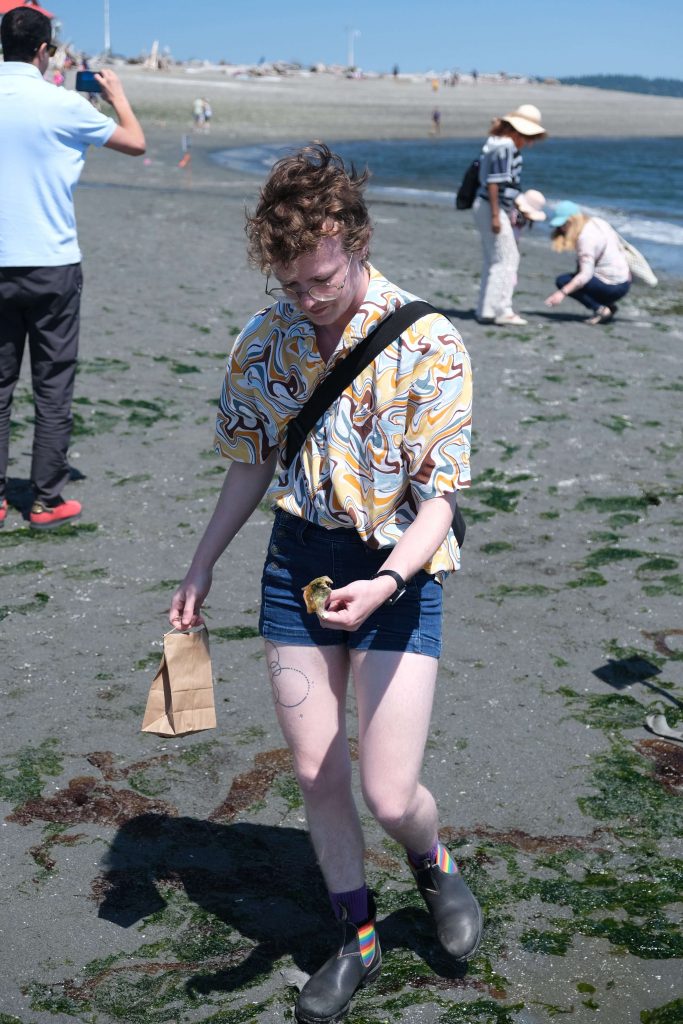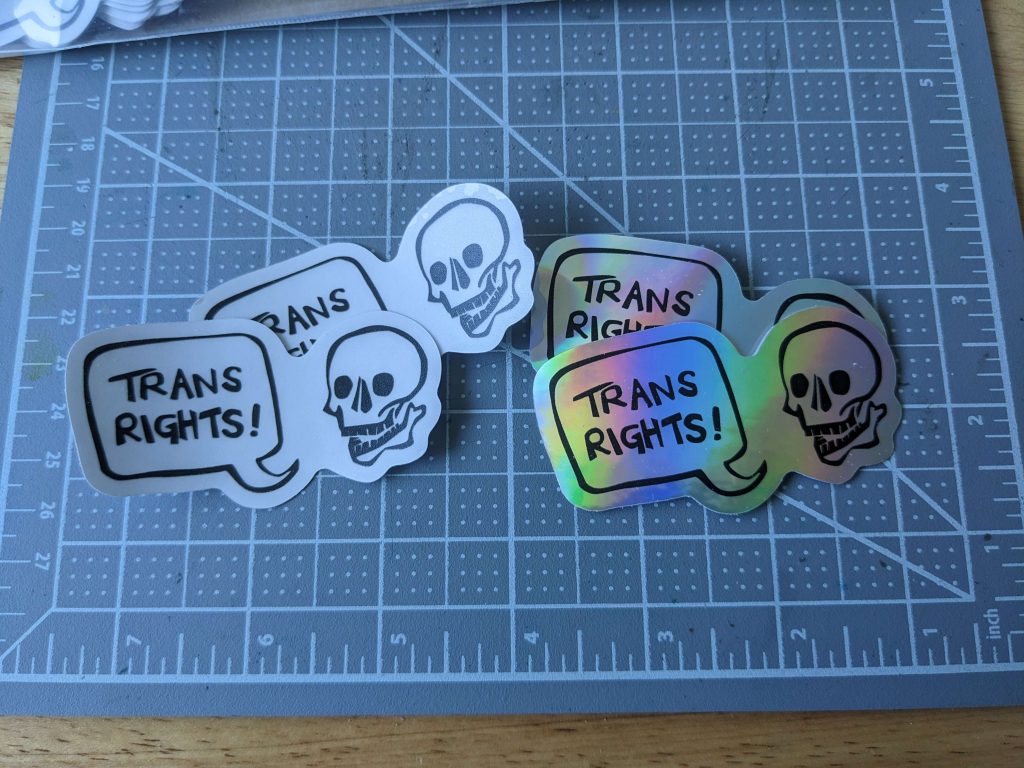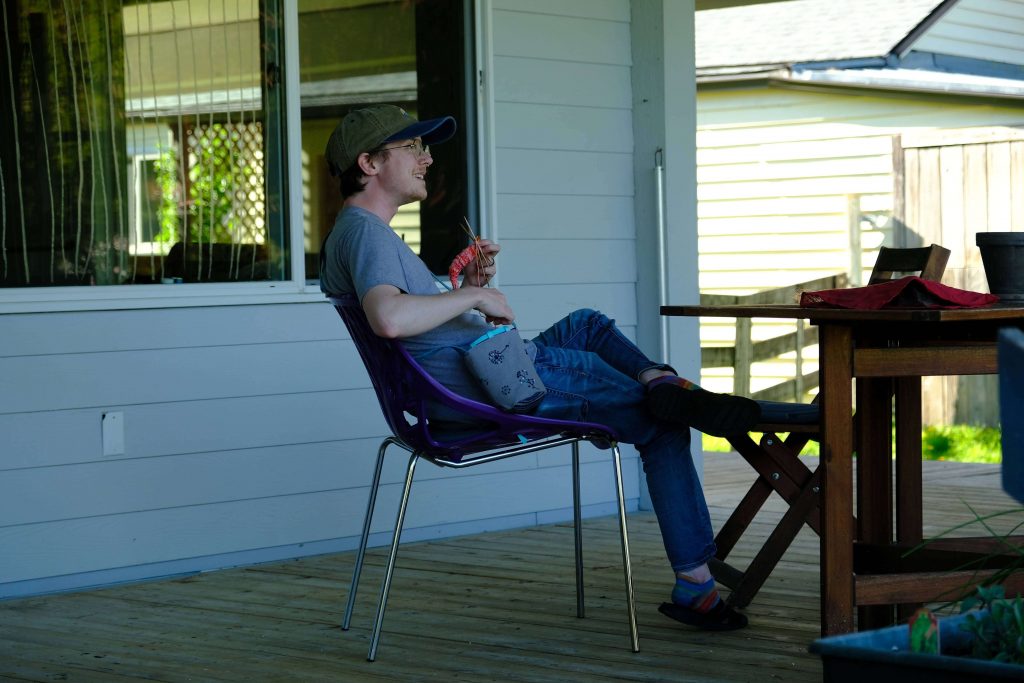This post is part of our Artisan Profiles series, promoting authentic artisans and their products. Artisans: get your store featured by joining our free Buy Handmade campaign. Read the others here.
Riverside Refuge Studios is a shop just getting started by Lee Cattarin and hir wife, Brooke. Lee is a hobbyist who dabbles in a variety of creative projects, from bookbinding to printmaking to embroidery, and any other craft ze can get hir hands on.
Welcome to the Artisans Co-op, Lee!

ARTISAN PROFILE
Artisan: Lee Cattarin (Ze/Hir, He/Him)
Shop: Riverside Refuge Studios, Leecat.art
Socials: Mastodon
Artisan Interview
(Transcript)
What’s the name of your business? What do you do?
So we’ve just settled on a name, it’s Riverside Refuge Studios. And it’s my wife and I working together. We still haven’t actually set up the business side Of things but We’re working on that. And the name is because her name is Brooke and my name is Lee. We’re a brook next to a lee– Riverside Refuge. Just sort of a fun pun on our names. And we do a whole variety of things. She does a lot of textile art, so she does a lot of custom jackets with like found arts and patches and detailed embroidery and such. A lot of, like, thrift store finds that get melded together into new works of art. And also just a fair number of other, like fiber arts things like, she needs a lot of embroidery and such.
And then I also do some fiber arts. I knit, I spin yarn, I embroider and do some stitch work and repairs and such, and then the other main things that I’m into is printmaking and bookbinding. So for printmaking, I’ve been largely doing little prints of birds that are generally like, 6 by 6 inches or 6 by 4 inches. They’re pretty small at this point, but I’ve definitely been scaling up slowly as I learn the skill, and I’ve also been making like, shirts with them, which is very fun. And then bookbinding, I’m very much a hobbyist, but I’ve started making custom sketchbooks and journals. I actually finally got some of my first commissions for custom sketchbooks, and it’s really nice to have people’s very specific dream in front of me and be able to fulfill that, you know, have someone be like, “I really want this to be a square and it needs to have a dot grid and I want this color scheme.” And it’s really nice to be able to just make that happen because I know that journal shopping and sketchbook shopping can be really persnickety, you know?
How long have you been creating?
Basically, my entire life. My mom, uh–Recently I got some of my work into a local store that has local artists work and my mom reminded me that this started with me making bookmarks as a kid and putting them outside my bedroom door for her and my dad to buy. So it’s been basically my whole life. I’ve always been very artsy other than like, a couple of years mid college where I was frankly a lot more depressed and I was not making as much art. But really it’s just constant. I do this to keep myself happy and keep the world around me good.
What does your creative process look like? Do you ever collaborate with your wife on things, or do you both do kind of separate hobbies, but sell them together?
Yeah, I mean, we’ll collaborate certainly on ideas, we’ll do a lot of like, talking through craft ideas or item ideas with each other and refining them that way. But we don’t actually do as much direct collaboration. There’s certainly, like she has jackets of hers that I’ve either done individual patches on or done some like stitch work on to liven them up, but that tends to be more her own jackets that she wears rather than the ones that she is making and selling. Those tend to be primarily her own. So we do some collaboration, but it is often sort of that we’re in our own work streams.
This is about the point in the written form that I was like, Oh my God, I’m saying too much because what my process looks like really depends on the medium. Printmaking I tend to start from a picture, I try to start from my own photography when possible, so I do a lot of bird photography, especially in a lot of wildlife and nature photography around my yard and around. The local area. Or like I’m about to do, one of a very fat raccoon that we’ve got in our yard and that’s based off a picture that Brooke took. So I start with photography. I work with a digital tablet on that photography to turn this very 3-dimensional, very multi colored image into something with only one or two layers of color. Generally for my prints it’s a layer of black details and a layer of like background or contrasting colors that might be like, all brown or it might be like some brown and some red, like sitting on my desk here. Here, I’ll turn my camera on for some context sitting on my desk here I’ve got this Stellar’s Jay print.

And as you see, one layer is the black detail layer that has a lot of the fine details and one layer is broader background colors and strokes. So it’s got the branch coloration, and then the blue of the jay. So a lot of my works are. Sort of like that where I just try to strip down a full image into something that can be very monochrome, very single layer or double layer. And then there’s a whole transfer process with the way that I print out an image and transfer it onto this pink carving medium. That’s frankly like magic. It’s very fascinating. You can use acrylic gel medium to basically take the image off of a printed paper and transfer it onto some other substance. It blows my mind.
And then I go about carving it and carving it. Pretty straightforward and I go around and do all the little details and then I take the rest of the material that I don’t need out with a big broad like U-shaped tool.
And then my printing itself is pretty straightforward. I use a brayer, which is this like foamy roller tool. No, yeah, there’s not too much complexity to that. I have the extremely high tech process of I take a carpenter square and I use some washi tape to tape the paper to it. If I want to do a multi-layer design so the paper stays in place.
Yeah, wildly high tech. We’re really working with fancy tools here. But yeah, so that’s most of printmaking. And then I guess the the other sort of fun creative process is the book binding because I frequently get to work with someone with their very specific needs about what they want in the sketchbook and having those restrictions and having those exact specifications is really fun for me creatively, because I I know where I get to have some freedom and I know where I get to just like work exactly to the rules.


Do you have a preference between printmaking or bookbinding? Or do you like both the same?
I like pretty much any craft I can get my hands on. So like those are the more major ones for me right now, but I’m also I’m still knitting, I’m still spinning. I’ve been playing with plant fiber so like this is seacel, it’s made of seaweed. So it’s really just like whatever creative thing I can get my hands. On a lot of. The time, and I’m always really open to learning and trying new things, like we took a basket weaving class a few weeks ago.
And that was really fun. And now I’m like, oh, I could get into basket weaving. I’ve learned a little bit of leather working, so I make little leather key chains. It’s really like, if I can get my hands on something, I’ll start it. Except crochet. I have not figured out crochet.
Is there anything in particular that inspires you with all of your crafts?
Very much nature and the outdoors. A lot of it is very drawn from outdoors and animals and wildlife because I I just do care a lot about that. And then also. The other sort of major theme running through some of my work is. Just like diversity and inclusion and and making things for all people like I have some, I have some little cards that I make that say “Congrats on the,” then there’s a few different words that fill in the blanks. So there’s a “Congrats on the ADHD”, “Congrats on the Autism.” The gay and just the gay in rainbow and like stuff like that, like especially the ADHD and autism ones. It’s really important to me to like, celebrate that right, because a lot of people’s response to a diagnosis can be super negative. But for many people receiving that diagnosis, like unlocks, how they can think about their own brain and how they can reason about themselves. And it’s like, really powerful and helpful. And at least like that, that was very much my experience. Like I want to celebrate that I want to celebrate queerness and queer community. I I want to celebrate all the ways that people are are different and like try to bring all those people to the table with our you know.
Would you say then that the people you try to include in your art are also your target audience then? Or is your audience far beyond that as well?
I mean, yeah. I think when I was looking at the form, my first answer to that was queers and birders. But yeah, broadly like I want to reach people who share values with me, whether that’s love of the outdoors or queerness and caring about building community or disability, or, you know, like I want to reach people that, the same values that resonate with me, resonate with them and then hopefully that comes through in the art and that they connect with that.
Do you have a piece of advice for your fellow artisans?
Well, that’s tricky. I don’t know. I still feel I’m still waiting for the moment where I feel like I am accomplished enough to be giving other people advice. Like I still feel somewhat new to everything, especially because like I haven’t fully set up a business and I haven’t fully set up a storefront and such. Um. I guess–this is so basic but like be curious. I know keeping my eyes open and being aware of the world and asking questions about the world leads me to learn a lot, and grow creatively and otherwise. So yeah, I guess very cliché advice.
It’s good advice though. Is there a part of the creation process that you enjoy the most? I know I asked a similar question.
No, that’s okay. I will say for printmaking actually getting to carve the stamps is the fun part. Like I like the digital design. I like making the prints. I like making the shirts, et cetera. But the real the real fun part, the real meat of it, is getting to sit down and really focus in on all these tiny details I’ve picked out and try to replicate those as best I can with my tools. Because it’s really it’s genuinely like the the digital designs I draw out are not anywhere near finished. They’re they’re drawn out with this understanding that like I know how the carving process works and I know what sort of limitations that carving process brings like. At some point I’m not going to get any smaller lines than I’m getting. I’m not going to get any smaller details when I’m getting–I’ve got a certain size of tool tip and that’s going to get me what it gets. So seeing that digital design, which often has like, rounded corners because I’m using just a standard round brush and like slightly sketchy details and areas where I know that like I need to do a lot of hatching but I don’t care what the hatching looks like in the digital design and stuff like that. Seeing that all come out in the in the carting step is is really fun.
Okay. Finally, what do you hope to gain from joining the Artisans Co-op?
It pretty open-ended at this point I’m super, I’m just super into co-ops in general as a mechanism for workers like it’s just a much powerful and much more promising model in my eyes. But one of the things that I’ve been looking for and that I’ve been sort of struggling with is that I would just like a storefront. I would just like an online storefront and Etsy seems like a real crap deal, and Ko-fi seems like a slightly better deal, and also one that really harshly punishes nudity or NSFW works, which I’ve seen through over some friends of mine. And I don’t really know that, but I want to get started on that. You know, if if it’s going to have these sort of very punitive puritanical policies, like another friend of mine is fighting with Etsy right now to get his dead name removed from a review and Etsy is extremely unhelpful, so it’s things like that where like I would like a storefront that’s actually trying to meet the needs of both makers and customers rather than meet the needs of itself as third party. So I’m just. I’m super excited to hear more about this model and learn more and be more involved.


About Artisans Cooperative
We are growing an online handmade marketplace for an inclusive network of creatives: a co-op alternative to Etsy.
Shop the marketplace!
